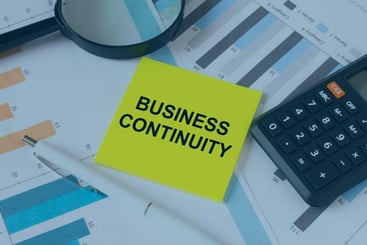Relevant Contents
Need Tailored Business Continuity Insights?
Contact Us Now for Personalized Guidance!
Compliance and alignment with regulatory mandates and industry standards is a cornerstone of business continuity management (BCM). While achieving compliance is challenging, the rewards are substantial and can include avoidance of penalties, competitive advantage, and significantly enhanced resilience.
The Dual Nature of Compliance in BCM
Compliance in BCM operates on two levels: regulatory and voluntary. Regulatory compliance is mandatory, driven by laws and regulations that require organizations to maintain continuity plans to protect critical operations, customers, and stakeholders. These requirements, which vary by industry and region, include GDPR for data protection in Europe, HIPAA for healthcare in the U.S., and the FFIEC guidelines for financial institutions.
Voluntary compliance involves aligning with recognized industry standards, such as ISO 22301 or NFPA 1600. While not legally required, these frameworks represent global best practices, offering organizations a roadmap to strengthen their resilience and preparedness.
Meeting regulatory requirements ensures legal adherence and mitigates risks like fines, lawsuits, and reputational damage. Adopting voluntary industry standards fosters operational resilience and potentially provides a competitive advantage by signaling a proactive commitment to continuity.
The Challenges of Achieving Compliance
Whether the goal is adhering to legal requirements, voluntarily aligning with standards, or both, the task of achieving compliance is uniquely challenging. The difficulties reside partly in the complexity and rigor of the regulations and standards and partly in the human challenge of inducing many people to pull in the same direction at the same time.
The following are some of the key challenges BC teams face in trying to achieve compliance, whether regulatory or voluntary.
Complexity of the global regulatory landscape
The global regulatory environment is increasingly complex, especially for organizations with international operations. The European Union has been especially active in implementing new regulations, including the GDPR, which focuses on data protection and privacy, and DORA, which addresses operational resilience in financial services. These frameworks set stringent requirements for managing data, ensuring cybersecurity, and maintaining continuity during disruptions. Navigating these regulations requires keeping pace with constant updates and firm deadlines. Non-compliance can lead to severe financial penalties.
Complexity of the voluntary standards landscape
The variety of BCM standards adds another layer of complexity. Frameworks like ISO 22301, NFPA 1600, the BCI Good Practice Guidelines, and industry-specific guides like the FFIEC Handbook can be confusing to navigate. Differences in detail, focus, and scope make it challenging to determine which standard to follow and how to implement it effectively.
Maintaining adequate documentation
Proper documentation is critical for demonstrating compliance and alignment with regulations and standards, ensuring audit readiness, and providing a clear framework for business continuity efforts. However, maintaining adequate documentation is challenging due to the need for accuracy, consistency, and regular updates. Common errors include allowing documentation to be compromised by outdated, missing, or garbled information, invalidating assessment results.
Securing management support
Winning leadership’s support for compliance with legal regulations is generally not a significant hurdle as the potential for penalties tends to prompt action. However, getting management to support a drive to achieve voluntary compliance with BC standards often presents a significant challenge. Managers are often unfamiliar with business continuity and unaware of its importance. Achieving alignment with a BC standard is difficult if not impossible without strong management support.
Coordinating across departments
Coordinating across departments is a critical challenge. BC teams rely heavily on the cooperation of other departments to achieve compliance. If departments do not actively and willingly engage, the entire compliance effort can be significantly hindered. It’s not uncommon for departments to delay their responses or provide incomplete or inaccurate information. This may stem from a reluctance to admit gaps in their preparedness or a desire to prioritize their own activities.
Achieving compliance in BCM is a significant challenge, one that requires navigating a complex landscape of regulations, standards, and human relationships. The challenges lie not only in the intricacies of compliance requirements but also in the need to win the support of people across various departments and levels of the organization.
The Benefits of Coming into Compliance
The challenges of achieving compliance are substantial; however, the benefits of doing so are even greater.
Complying with regulatory requirements helps organizations avoid penalties, fines, and reputational damage. Adhering to data protection laws or operational resilience frameworks mitigates the risk of legal liability and enhances trust with customers, stakeholders, and regulators. It also strengthens the ability of organizations to respond to disruptions.
Aligning with voluntary BC standards enhances the ability of organizations to respond, recover, and restore operations after an event. It demonstrates a proactive approach to continuity and resilience that can lead to improved stakeholder confidence, a stronger reputation, and a competitive edge in industries where business continuity is highly valued.
Strategies for Business Continuity Teams to Face Compliance Challenges
Let’s close the gap between the challenges of achieving compliance and the benefits of being compliant with legal requirements and in alignment with BC standards.
The following are some strategies BC teams can follow to address the most daunting compliance challenges.
Commit to actively monitoring the evolving global regulatory landscape
Don’t miss my recent post on DORA, the Digital Operational Resilience Act, which goes into effect in the EU in January 2025.
Familiarize yourself with the leading business continuity standards
Choose a standard that is specific and directive (such as NFPA 1600) rather than one that is beautiful but vague (like ISO 22301).
Don’t think you need to achieve 100% alignment with a standard for your compliance effort to be worthwhile
With most standards, a compliance level of 70 to 75 percent equates to a strong, demonstrated capability to respond and recover.
Document, ask for, and keep track of everything
policies, standards, business impact analyses (BIAs), threat and risk assessments, crisis plans—every sort of supporting documentation. Most auditors, internal and external, are positively impressed by thorough documentation even if the picture painted is less than perfect. They want to see progress, even if incremental.
Work to establish a culture of compliance at your organization
Seek to educate management and your peers on BC basics and the value of compliance. Conduct regular, relevant training for employees. In the financial industry, ensuring compliance is as automatic as breathing. Other sectors would benefit from the same approach.
Be rigorous in setting the baseline
Your first assessment should be very thorough, painfully so. When you identify the standard you’re going to align with, put it in your policy and adhere to it steadfastly.
Contextualize your requests for assistance from other departments
Tell them why their input is valuable to the organization. Emphasize the importance of accurate data and information and the nonjudgmental nature of the activity.
Be realistic
Accept that achieving compliance will take time, money, and resources.
Consider bringing in outside help
The right BC consultant can provide critical guidance on complying with regulatory requirements or selecting a BC standard that makes sense for your organization. At MHA, our consultants eat, breathe, and sleep compliance.
Consider implementing a software solution for tracking and maintaining compliance
Many such tools are available. I’m partial to the one I created, which is the one MHA consultants use every day in carrying out current state engagements with our customers. It’s called Compliance Confidence (C2) and it’s part of our BCMMetrics platform. It automates the compliance process, taking out the guesswork and letting users assess their compliance against one or all of the leading BC standards and regulations. It also provides comprehensive scoring and reporting to show your successes, gaps, and opportunities. Learn more about Compliance Confidence.
Raising the Bar
To wrap up, I’d like to share my personal take on the push for stricter business continuity regulations. The move toward tighter rules around resilience—combined with growing customer expectations for stronger BC positions from their suppliers—is a positive shift. These measures protect stakeholders by making robust continuity practices a mandatory standard rather than just an aspiration. Publicly held companies and any organization engaged in critical activities should be held to high resilience standards.
I especially applaud the EU’s efforts in this area. They aren’t messing around. By crafting smart standards, setting firm deadlines for implementation, and enforcing meaningful penalties for violations, they’re leading the way. This proactive approach is raising the bar for business continuity globally.
Facing the Challenge, Reaping the Reward
Achieving compliance in business continuity management is undoubtedly challenging, given the complexity of regulations, standards, and organizational dynamics. However, with the right strategies—such as fostering a culture of compliance, maintaining thorough documentation, and leveraging expert guidance—it’s possible to navigate these challenges effectively.
The effort to achieve compliance is well worth it, as it strengthens organizational resilience, protects stakeholders, and enhances trust. Looking ahead, organizations that prioritize compliance will be better equipped to thrive in an increasingly regulated and unpredictable world.
Further Reading
- Are You a Leader in BCM Governance, Risk and Compliance (GRC)?
- Ensuring Compliance Using Compliance Confidence
- GDPR Compliance: A Heads-Up for Business Continuity Professionals
- Standard Time: The Best Time to Choose a Business Continuity Standard Is Right Now
- How to Go from Adopting a BC Standard to Knowing What to Do to Comply with It
- FFIEC: An Introduction to BCM’s Gold Standard
- Exploring DORA: The EU’s Excellent New Digital Resilience Standard

Michael Herrera
Michael Herrera is the Chief Executive Officer (CEO) of MHA. In his role, Michael provides global leadership to the entire set of industry practices and horizontal capabilities within MHA. Under his leadership, MHA has become a leading provider of Business Continuity and Disaster Recovery services to organizations on a global level. He is also the founder of BCMMETRICS, a leading cloud based tool designed to assess business continuity compliance and residual risk. Michael is a well-known and sought after speaker on Business Continuity issues at local and national contingency planner chapter meetings and conferences. Prior to founding MHA, he was a Regional VP for Bank of America, where he was responsible for Business Continuity across the southwest region.



